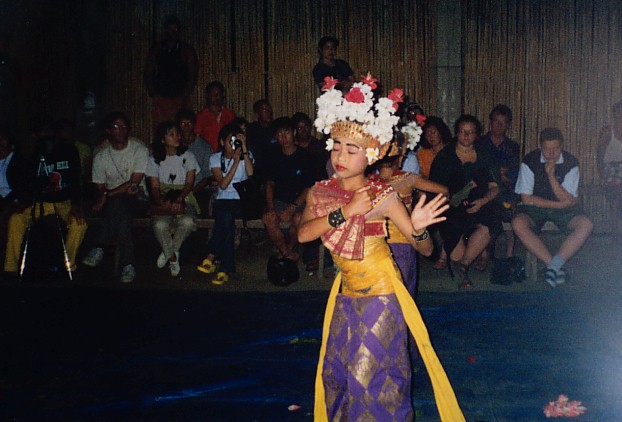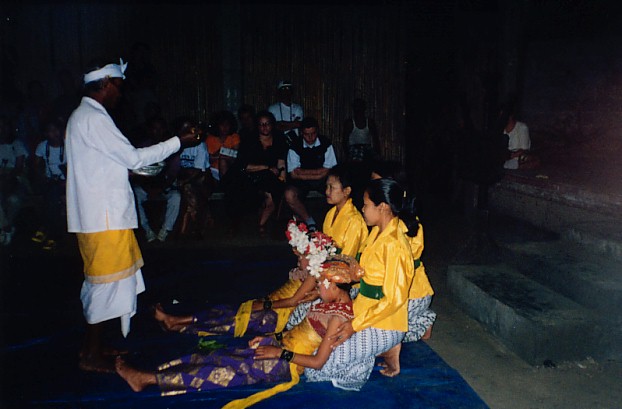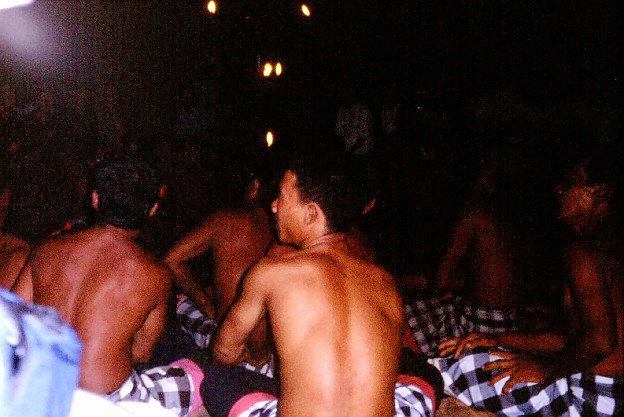Kecak - The Monkey Chant |
|||||||||||||||||||||||||||||||||||||||||||||||||||||||||||||||||||||||||||||||||||||||||||||||||||||||||||||||||||||||||||||||||||||||||||||||||||||||||||||||||||||||||||||||||||||||||||||||||||||||||||||||||||||||||||||||||||||||||||||||||||||||||||||||||||||||||||||||||||||||||||||||||||||||||||||||||||||||||||||||||||||||||||||||||||||||||||||||||||||||||||||||||||||||||||||||||||||||||||||||||||||||||||||||||||||||||||||||||||||||||||||||||||||||||||||||||||||||||||||||||||||||||||||||||||
|
|
Perhaps fittingly after visiting the Monkey Forest, we decided to see an evening performance of Kecak - Monkey Chant. We crammed into a minivan for the 30 minute drive to the village of Bona, where the performance was to be held in a dusty Banjar hall. It was very dark in the hall, and very difficult to take any photographs. It definitely seemed to be a village performance, fairly unpolished and simple, which, depending on your point of view, might be considered more "authentic" than a more polished, professional performance. In fact, photographs dating back to 1936 show the kecak being performed in Bona village, so it has been going on here since the beginning. |
||||||||||||||||||||||||||||||||||||||||||||||||||||||||||||||||||||||||||||||||||||||||||||||||||||||||||||||||||||||||||||||||||||||||||||||||||||||||||||||||||||||||||||||||||||||||||||||||||||||||||||||||||||||||||||||||||||||||||||||||||||||||||||||||||||||||||||||||||||||||||||||||||||||||||||||||||||||||||||||||||||||||||||||||||||||||||||||||||||||||||||||||||||||||||||||||||||||||||||||||||||||||
|
|
Based on the Ramayana
story of the abduction of Sita and her subsequent rescue by an army of
monkeys, the monkey chant is performed a cappella by a large "choir"
of men, who sit cross-legged in a tight circle forming a huge human mandala.
As they chant the singers raise their arms in a sort of seated dance,
swaying from side to side, and laying back against each other, all as
one, as the mandala comes alive. The choir chatters like monkeys, and
croaks like frogs, as the story of Sita's abduction is told. It's quite
intense and mesmerizing, as the chant rolls along, the voices rising and
falling in unison, as a fast interlocking chatter. From time to time figures,
such as Sita herself, Hanuman the king of the monkeys, etc, would appear
and act out parts of the story. |
||||||||||||||||||||||||||||||||||||||||||||||||||||||||||||||||||||||||||||||||||||||||||||||||||||||||||||||||||||||||||||||||||||||||||||||||||||||||||||||||||||||||||||||||||||||||||||||||||||||||||||||||||||||||||||||||||||||||||||||||||||||||||||||||||||||||||||||||||||||||||||||||||||||||||||||||||||||||||||||||||||||||||||||||||||||||||||||||||||||||||||||||||||||||||||||||||||||||||||||||||||||||
|
|
 After
the kecak, there was a presentation of a "trance dance", with
two young girls, supposedly in trance, dancing in a swaying, mesmerized
way, and then standing on the shoulders of two men, and swaying back and
forth as the gamelan music played. These are the girls in "trance". After
the kecak, there was a presentation of a "trance dance", with
two young girls, supposedly in trance, dancing in a swaying, mesmerized
way, and then standing on the shoulders of two men, and swaying back and
forth as the gamelan music played. These are the girls in "trance". |
||||||||||||||||||||||||||||||||||||||||||||||||||||||||||||||||||||||||||||||||||||||||||||||||||||||||||||||||||||||||||||||||||||||||||||||||||||||||||||||||||||||||||||||||||||||||||||||||||||||||||||||||||||||||||||||||||||||||||||||||||||||||||||||||||||||||||||||||||||||||||||||||||||||||||||||||||||||||||||||||||||||||||||||||||||||||||||||||||||||||||||||||||||||||||||||||||||||||||||||||||||||||
|
|
 At the end of the dance the girls "fainted" simultaneously, and
were brought out of their trance with holy water from the priest.
At the end of the dance the girls "fainted" simultaneously, and
were brought out of their trance with holy water from the priest.
|
||||||||||||||||||||||||||||||||||||||||||||||||||||||||||||||||||||||||||||||||||||||||||||||||||||||||||||||||||||||||||||||||||||||||||||||||||||||||||||||||||||||||||||||||||||||||||||||||||||||||||||||||||||||||||||||||||||||||||||||||||||||||||||||||||||||||||||||||||||||||||||||||||||||||||||||||||||||||||||||||||||||||||||||||||||||||||||||||||||||||||||||||||||||||||||||||||||||||||||||||||||||||
 Finally there was a fire dance - palm debris was piled up on the floor,
set ablaze, and then spread out. A man in "trance" and riding
a straw hobby-horse ran through the glowing embers, evidently without pain,
and then proudly displayed his black but unblistered feet for inspection
(next to a tip jar). It all seemed a little contrived to me. I'm sure this
happens commonly in true ritual context, but to turn it on every evening
for the tourists seemed like more of a re-enactment than the real thing.
Finally there was a fire dance - palm debris was piled up on the floor,
set ablaze, and then spread out. A man in "trance" and riding
a straw hobby-horse ran through the glowing embers, evidently without pain,
and then proudly displayed his black but unblistered feet for inspection
(next to a tip jar). It all seemed a little contrived to me. I'm sure this
happens commonly in true ritual context, but to turn it on every evening
for the tourists seemed like more of a re-enactment than the real thing.
|
|||||||||||||||||||||||||||||||||||||||||||||||||||||||||||||||||||||||||||||||||||||||||||||||||||||||||||||||||||||||||||||||||||||||||||||||||||||||||||||||||||||||||||||||||||||||||||||||||||||||||||||||||||||||||||||||||||||||||||||||||||||||||||||||||||||||||||||||||||||||||||||||||||||||||||||||||||||||||||||||||||||||||||||||||||||||||||||||||||||||||||||||||||||||||||||||||||||||||||||||||||||||||
|
|
Back home in the cramped minivan, and looking forward to our trip tomorrow.
|
||||||||||||||||||||||||||||||||||||||||||||||||||||||||||||||||||||||||||||||||||||||||||||||||||||||||||||||||||||||||||||||||||||||||||||||||||||||||||||||||||||||||||||||||||||||||||||||||||||||||||||||||||||||||||||||||||||||||||||||||||||||||||||||||||||||||||||||||||||||||||||||||||||||||||||||||||||||||||||||||||||||||||||||||||||||||||||||||||||||||||||||||||||||||||||||||||||||||||||||||||||||||
|
|
|
||||||||||||||||||||||||||||||||||||||||||||||||||||||||||||||||||||||||||||||||||||||||||||||||||||||||||||||||||||||||||||||||||||||||||||||||||||||||||||||||||||||||||||||||||||||||||||||||||||||||||||||||||||||||||||||||||||||||||||||||||||||||||||||||||||||||||||||||||||||||||||||||||||||||||||||||||||||||||||||||||||||||||||||||||||||||||||||||||||||||||||||||||||||||||||||||||||||||||||||||||||||||
